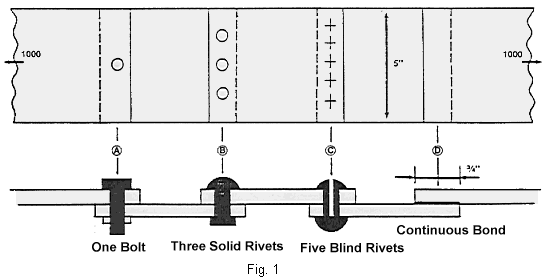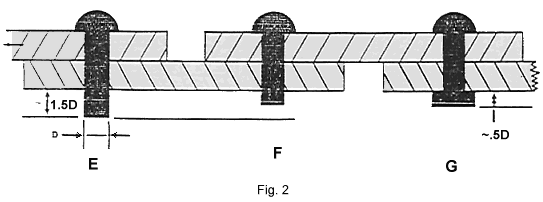By Chris Heintz, P. Eng
[This article is part of a series, where aeronautical engineer Chris Heintz discusses light aircraft design and construction.]
This month we’ll focus on riveting metal aircraft. explaining the various types of rivets available and the hows and whys of their usage.
Aircraft raw materials come in different but limited sizes due to manufacturing limitations as well as economical distribution. The designer has to choose materials which are available, can be transported to the manufacturing facility (even the homebuilder's basement or garage), can be cut to required sizes with the minimum tools, and can be handled without causing too many rejects due to mishandling ... and still end up with an aircraft of appreciable size, adequate strength and good looks. Aircraft can't just be made out of one big sheet of material and "wrapped together." Rather, various parts have to be formed out of different types of material and joined together. Each of those parts carries a load and the fastener that brings these parts together has to carry the load from one part to the other. If we have, for example, 1,000 lbs. to be carried over from one skin to another, we can choose various ways of achieving this (see figure 1).
The designer of an aircraft chooses the solutions best adapted to the materials used - a continuous joint with wood and composites, a single bolt or heavy (thick) fittings with steel; or riveted joints on relatively light gauge materials and/or when the joints are long (to avoid the weight penalty of many steel bolts).
For over 50 years, riveted aluminum structures have been very successful, and are found to varying degrees on virtually all aircraft (whether the complete airframe or just an instrument panel). They do not fail under static or repeated loads and they do not corrode if the rivets are well chosen and properly set.
How to set the rivets correctly can be learned quite easily and should be explained by the designer when he sells drawings or kits to build an aluminum aircraft. The choice of rivets is very simple: only 2017 alloy rivets are commercially readily available (these are the "AD" rivets mentioned in earlier columns). They have good corrosion resistance and are compatible with 2024 and 6061 materials.
Now, let's look at why they are also a good structural fastener. (See figure 2). First the hole is drilled slightly oversized (via the use of number drills) so that the rivet can easily be introduced after deburring (see Figure 2, item E).
Note that the drawing also indicates correct rivet size depending on the total metal thickness, called the "grip'. Then the rivet is squeezed (compression is achieved by a rivet 'gun" and a "bucking bar". The pneumatic gun hammers on one side while the bucking bar, which is simply a heavy chunk of steel, provides the reaction on the other.)
When the rivet shank is compressed, its diameter grows until the hole is completely filled. (See Figure 2, item F). When we further compress the rivet it can only grow further outside the hole and thus the formed head is shaped (see Figure 2, item G), which also gives a correct formed head dimension. Note that a visual inspection of the rivet will immediately tell you if the rivet is good or if it has to be drilled out and replaced.
Such easy inspection is obviously not possible on a bonded or glued joint, which can cause such joints to be less reliable.
Next, let's look at what makes the set rivet (AD rivet) a good fastener.
- First, AD rivets are manufactured with adequate quality control which guarantees you the correct alloy (when you mix bonding cement or resins. you are responsible!)
- The rivet fills the hole completely so that no relative motion is possible.
- The original as well as the formed head both rest both very well an the parts having been compressed into place. This makes for a snug and sealed joint which will prevent any water from creeping under the heads and corroding underneath.
Also very important is the fact that the heads squeeze assembled parts tightly together and when the loads are applied (see arrows on Figure 2), part of the load is transmitted from one sheet to the other by friction. It just happens in aircraft (this is not the case with racing cars) that the part of the load transmitted by friction corresponds to the high frequency engine loads which would otherwise fatigue the rivet (or require an overdesign of the rivet joint which is done in racing cars where the engine vibration loads are much larger with respect to the static loads). As mentioned, solid riveting when correctly done is an excellent fastener - both reliable and durable. But it also has some drawbacks:
- You need special equipment (you'll need to buy an air compressor, rivet gun(s), rivet snaps and bucking bars);
- You need some expertise and prior practice (you’ll need a good teacher for this - errors can be costly in more ways than one);
- It is noisy (your family and neighbors may object to your setting rivets in your basement or garage after 10 p.m. or on Sunday morning . . . and that is just when you have the time for it);
- You need access to both sides of the parts to be assembled (and this is obviously not always easy or possible: How will you get the bucking bar inside an aileron of a small aircraft?). You’ll often need a helper to "buck" the rivet on the other side, or have long skinny arms and/or a full assortment of bucking bars.
So another solution has been devised - blind rivets, which have none of the above-mentioned disadvantages. Blind or pull rivets, often incorrectly referred to as "pop" rivets, have been used on aircraft since the production of the DC-3 (the tubular 'Chobert' rivets). In the next article we will discuss the good and also the questionable qualities of blind rivets in more detail. More on blind riveting: EAA "Hints for Homebuilders" Video
|


